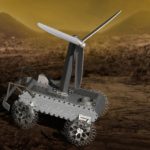Exploring Hell: Avoiding Obstacles on a Clockwork Rover
To explore the daunting surface of Venus, NASA needs an innovative obstacle avoidance sensor for its mechanical clockwork rover.
Challenge Overview
Imagine a world hot enough to turn lead into a puddle, where the atmospheric pressure can crush a nuclear-powered submarine. Now imagine sending a rover to explore that world.
Venus, ancient sister of Earth with a planetary environment just this side of hellish, has been visited by a handful of probes since the early days of space flight. Of the many missions to our celestial neighbor, only about a dozen have made contact with the surface of the planet. The longest-lived landers only managed to function for a couple of hours before succumbing to the relentlessly oppressive heat and pressure.
Despite the punishing conditions, previous missions to Venus have nevertheless delivered important information, such as:
- Surface temperature: in excess of 450°C
- Surface pressure: 92 times that of Earth
- Wind speeds: 0.3 – 1.3 meters per second
- Due to the extreme pressure, this low wind speed feels almost like gale-force winds here on Earth
- Length of Venusian day: 116 Earth days
NASA’s Jet Propulsion Laboratory (JPL), under a grant from the NASA Innovative Advanced Concepts (NIAC) program, is studying a mission concept to return to the surface of Venus, known as the Automaton Rover for Extreme Environments (AREE), something not accomplished since the Soviet Vega 2 landed in 1985.
Current, state-of-the-art, military-grade electronics fail at approximately 125°C, so mission scientists at JPL have taken their design cues from a different source: automatons and clockwork operations. Powered by wind, the AREE mission concept is intended to spend months, not minutes, exploring the landscape of our sister world. Built of advanced alloys, AREE will be able to collect valuable long-term longitudinal scientific data utilizing both indirect and direct sensors.
As the rover explores the surface of Venus, collecting and relaying data to an orbiter overhead, it must also detect obstacles in its path like rocks, crevices, and steep terrain. To assist AREE on its groundbreaking mission concept, JPL needs an equally groundbreaking obstacle avoidance sensor, one that does not rely on vulnerable electronic systems. For that reason, JPL is turning to the global community of innovators and inventors to design this novel avoidance sensor for AREE. JPL is interested in all approaches, regardless of technical maturity.
This sensor will be the primary mechanism by which the potential rover would detect and navigates through dangerous situations during its operational life. By sensing obstacles such as rocks, crevices, and inclines, the rover would then navigate around the obstruction, enabling the rover to continue to explore the surface of Venus and collect more observational data.
JPL has issued this Challenge to the global community because the rover must have the ability to successfully navigate in such a demanding environment in order to qualify for additional developmental funding. While the mission to the surface of Venus may be years off, the development of a suitably robust rover sensor will strengthen the case for returning to Venus with a rover, something that has never been attempted before.
What You Can Do To Cause A Breakthrough
- Click ACCEPT CHALLENGE to sign up for the challenge
- Read the Challenge Guidelines to learn about the requirements and rules
- Share this challenge. Show your friends, your family, or anyone you know who has a passion for discovery.
- Start a conversation in our Forum, or join an existing conversation, ask questions or connect with other innovators.



